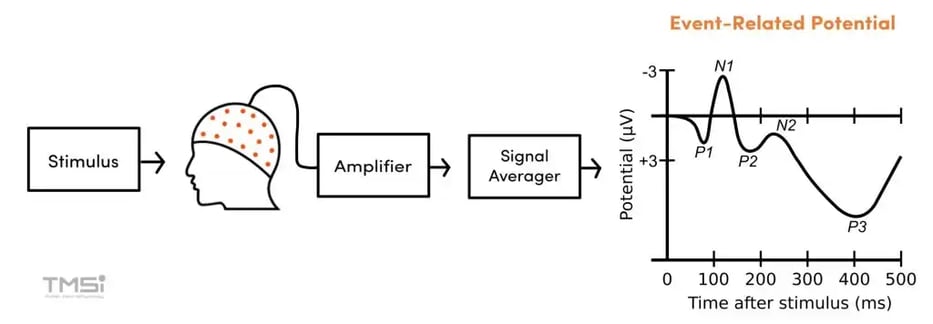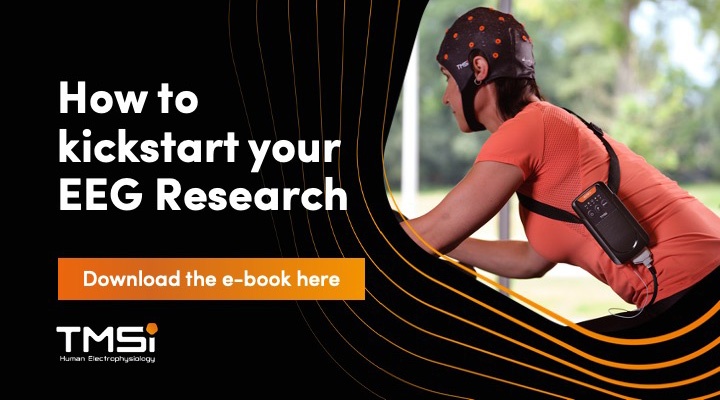An introduction to event-related potentials.
What is an event-related potential?
An event-related potential (ERP) is the neural response associated with a specific sensory, cognitive, or motor event (e.g. a stimulus). An ERP is often recorded using scalp electroencephalography (EEG) and looks at the average change in voltage over time starting at the onset of the stimulus over multiple trials. ERP measurements have a precise temporal resolution, which is useful in testing perception and attention.1 This information can be used to evaluate brain functioning by looking at how the brain normally processes information, as well as viewing how this processing may differ in neurological or psychiatric disorders.2
What is the history of ERPs?
The first sensory ERP recordings were performed by Pauline and Hallowell Davis in 1935-1936.3 Later, in 1964 and 1965, Walter and colleagues and Sutton and colleagues made major advancements by discovering the first two cognitive ERP components, which started the modern era of ERP research.4,5 With these developments, and combined with further advancements in computers and technology, ERP research became more popular. Today, ERPs are one of the most widely used methods in cognitive neuroscience research to study the physiological correlation between the presentation of stimuli and information processing. An application of this can be identifying differences in the neuronal responses of a healthy individual compared to someone with a (potential) neurological condition.
How can you record an ERP?
Event-related potentials are evoked by stimuli and measured at the scalp with EEG. They are recorded in response to an isolated, discrete event. Usually, this stimulus is presented multiple times, which allows the EEG to be averaged after discarding low-quality trials. This way, the ERP waveforms become clear. In Figure 1, this process is shown schematically.

Figure 1: Schematic process of Event-Related Potentials (adapted from this and this photo)
How can you trigger an ERP?
Any sensory, motor, or cognitive stimulus can trigger an ERP. The vast majority of cognitive ERP experiments use auditory or visual stimuli. In addition, there have been experiments with somatosensory, olfactory, and gustatory responses.6 In 1994, the American Electroencephalographic Society provided guidelines for the different stimuli and how to describe them in your research.7
What can an ERP experiment look like?
The stimuli in an ERP experiment are typically separated from each other by a long and/or variable interstimulus interval. This interval allows for the brain to return to a baseline state before the next stimulus is given. The “oddball” paradigm is the most frequently used ERP paradigm.8 In these experiments, the subject is shown a train of standard stimuli (e.g. image of a cat) that is interjected with a random deviant stimulus (e.g. image of a tree). The subject must only respond to the deviant target stimulus rather than the frequent standard stimulus. As the subject is unaware of what stimulus will be presented, this paradigm can provide useful information about how the brain discriminates stimuli and evaluates probability.8
What are the characteristics of an ERP?
ERPs consist of a sequence of peaks and waves characterized by latency, amplitude, configuration, and the interval between individual peaks. The timing of these responses is thought to provide a measure of the brain's communication speed or information processing. The peaks and waves of the ERP are believed to originate from different neuronal processes. In studies, they are distinguished from each other by their label. They have a letter indicating their polarity, positive (P) or negative (N), and are followed by a number indicating the group of latencies in milliseconds. For example, the aforementioned “oddball” paradigm generates a P300 ERP (also called P3), a large amplitude positive wave after roughly 300 milliseconds.
Conclusion
As mentioned above, ERPs are an informative and widely used tool in research. They are used in the fields of neuroscience, neurolinguistics, brain-computer interfaces, cognitive science, cognitive psychology, and psycho-physiological research. At TMSi, we understand the importance of high-quality systems in these applications. To read more about our products and accessories for cognitive performance, click here.
References
1. Woodman G. F. (2010). A brief introduction to the use of event-related potentials in studies of perception and attention. Attention, perception & psychophysics, 72(8), 2031–2046. https://doi.org/10.3758/APP.72.8.2031
2. Picton, T. W., Bentin, S., Berg, P., Donchin, E., Hillyard, S. A., Johnson, R., Jr, Miller, G. A., Ritter, W., Ruchkin, D. S., Rugg, M. D., & Taylor, M. J. (2000). Guidelines for using human event-related potentials to study cognition: recording standards and publication criteria. Psychophysiology, 37(2), 127–152.
3. Davis, H., Davis, P., Loomis, A., Harvey, E., & Hobart, G. (1939). ELECTRICAL REACTIONS OF THE HUMAN BRAIN TO AUDITORY STIMULATION DURING SLEEP. Journal Of Neurophysiology, 2(6), 500-514. https://doi.org/10.1152/jn.1939.2.6.500
4. WALTER, W., COOPER, R., ALDRIDGE, V., McCALLUM, W., & WINTER, A. (1964). Contingent Negative Variation : An Electric Sign of Sensori-Motor Association and Expectancy in the Human Brain. Nature, 203(4943), 380-384. doi: 10.1038/203380a0
5. Sutton, S., Braren, M., Zubin, J., & John, E. R. (1965). Evoked-potential correlates of stimulus uncertainty. Science (New York, N.Y.), 150(3700), 1187–1188. https://doi.org/10.1126/science.150.3700.1187
6. Luck, Steven. (2005). An introduction to event-related potentials and their neural origins. An Introduction to the Event-Related Potential Technique. 107.
7. American Electroencephalographic Society Guidelines in Electroencephalography, Evoked Potentials, and Polysomnography. (1994). Journal of clinical neurophysiology : official publication of the American Electroencephalographic Society, 11(1), 1–147.
8. Picton, T., Bentin, S., Berg, P., Donchin, E., Hillyard, S., & Johnson, R. et al. (2000). Guidelines for using human event-related potentials to study cognition: Recording standards and publication criteria. Psychophysiology, 37(2), 127-152. doi: 10.1111/1469-8986.3720127

